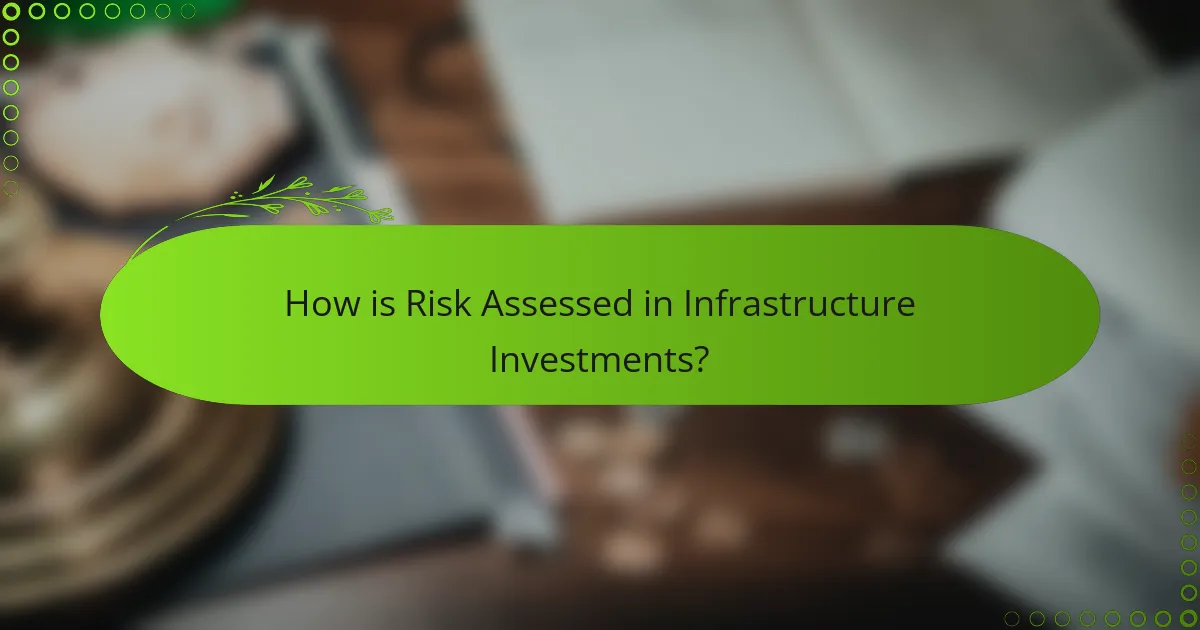
What are Infrastructure Investments?
Infrastructure investments are financial commitments made to develop, maintain, and improve physical structures and facilities. These investments typically focus on sectors such as transportation, utilities, and communication systems. They play a crucial role in economic growth by enhancing productivity and connectivity. According to the Global Infrastructure Outlook, global infrastructure investment needs are projected to reach $94 trillion by 2040. This highlights the increasing demand for infrastructure development worldwide. Infrastructure investments can also provide stable returns over time, making them attractive to investors. They often involve public-private partnerships, which leverage both public funding and private expertise.
How do Infrastructure Investments function in the economy?
Infrastructure investments function as a catalyst for economic growth. They enhance productivity by improving transportation, utilities, and communication systems. Efficient infrastructure reduces costs for businesses and increases access to markets. It also creates jobs during construction and maintenance phases. According to the World Bank, every $1 invested in infrastructure can yield up to $4 in economic returns. Additionally, infrastructure investments stimulate private sector participation. They attract foreign direct investment by creating a favorable business environment. Overall, robust infrastructure underpins sustainable economic development.
What are the key components of Infrastructure Investments?
The key components of infrastructure investments include capital, assets, and management strategies. Capital refers to the financial resources required for development and maintenance. Assets encompass physical structures such as roads, bridges, and utilities. Management strategies involve planning, operation, and oversight of infrastructure projects. These components work together to ensure effective investment and sustainability. Infrastructure investments often require long-term commitments and strategic partnerships. They contribute significantly to economic growth and public welfare.
How do Infrastructure Investments impact economic growth?
Infrastructure investments significantly impact economic growth by enhancing productivity and creating jobs. Improved infrastructure reduces transportation costs and increases efficiency for businesses. For example, studies show that every dollar invested in infrastructure generates approximately $1.50 in economic returns. Additionally, infrastructure development leads to increased private sector investment. This investment stimulates local economies and boosts employment rates. Moreover, better infrastructure attracts foreign direct investment, further contributing to economic expansion. Historical data supports this, as countries with robust infrastructure systems tend to experience faster GDP growth.
What are the various types of Infrastructure Investments?
There are several types of infrastructure investments. These include transportation, utilities, social infrastructure, and digital infrastructure. Transportation investments involve roads, bridges, and railways. Utilities investments focus on water supply, electricity generation, and waste management. Social infrastructure includes schools, hospitals, and community facilities. Digital infrastructure encompasses broadband networks and data centers. Each type plays a crucial role in economic development and public welfare. Infrastructure investments can yield long-term financial returns and enhance societal benefits.
Which sectors are primarily involved in Infrastructure Investments?
The sectors primarily involved in infrastructure investments include transportation, energy, water and wastewater, telecommunications, and social infrastructure. Transportation infrastructure encompasses roads, bridges, airports, and railways. Energy infrastructure includes power generation, transmission, and distribution facilities. Water and wastewater infrastructure involves systems for water supply and sewage treatment. Telecommunications infrastructure covers networks for internet and communication services. Social infrastructure refers to facilities such as schools, hospitals, and housing. These sectors are critical for economic development and provide essential services to communities.
What are the characteristics of public vs. private Infrastructure Investments?
Public infrastructure investments are typically funded and managed by government entities. They prioritize public welfare and social benefits. These investments often have long-term horizons, with a focus on essential services like transportation and utilities. Public investments may face budget constraints and bureaucratic processes.
Private infrastructure investments are funded by private entities or investors. They aim for profitability and return on investment. These projects often have shorter timelines and may prioritize efficiency and innovation. Private investments can be more flexible but may lack the same level of public accountability.
Both types of investments can significantly impact economic growth and development. Public investments often provide foundational infrastructure, while private investments can drive technological advancements and efficiency.

What are Sharia-Compliant Infrastructure Investment Options?
Sharia-compliant infrastructure investment options include projects that adhere to Islamic law principles. These investments often focus on sectors like renewable energy, transportation, and healthcare. They avoid industries related to alcohol, gambling, and interest-based financing. Common structures include Sukuk, which are Islamic bonds that fund infrastructure projects. Additionally, partnerships such as Mudarabah and Musharakah are used to share profits and risks. These options promote ethical investment while providing economic benefits. The global market for Sharia-compliant investments has been growing, indicating increasing interest and viability.
How do Sharia principles influence Infrastructure Investments?
Sharia principles significantly influence infrastructure investments by promoting ethical financing and risk-sharing. These principles prohibit interest (riba) and encourage investments in socially responsible projects. Sharia-compliant investments must align with Islamic values, which often leads to funding for sustainable and community-focused infrastructure. For example, projects in renewable energy or affordable housing are favored. Additionally, risk-sharing mechanisms, such as profit-and-loss sharing, are employed to ensure fairness. This approach mitigates financial risks while fostering economic growth. Studies indicate that Sharia-compliant investments can enhance project viability and attract diverse funding sources.
What are the core tenets of Sharia-compliant finance?
The core tenets of Sharia-compliant finance include the prohibition of riba, or interest. Riba is considered exploitative and unjust. Transactions must be based on tangible assets or services. This ensures that investments are ethical and productive. Gharar, or excessive uncertainty, is also prohibited. All parties in a transaction must have clear terms and conditions. Investments must align with Islamic principles, avoiding industries like alcohol or gambling. Profit and loss sharing is encouraged, fostering equitable partnerships. These principles ensure that financial activities promote social justice and economic stability.
How can investors identify Sharia-compliant projects?
Investors can identify Sharia-compliant projects by assessing adherence to Islamic law. Key criteria include the prohibition of interest (riba), avoidance of excessive uncertainty (gharar), and exclusion of businesses involved in unethical activities. Projects must also align with ethical and social responsibility principles. Investors often consult Sharia scholars or advisory boards for guidance. Additionally, they can refer to Sharia-compliant investment funds that screen projects based on these criteria. The Islamic Financial Services Board provides guidelines that can aid in this identification process.
What are the benefits of Sharia-compliant Infrastructure Investments?
Sharia-compliant infrastructure investments offer several benefits. They promote ethical finance by adhering to Islamic law, which prohibits interest and speculative activities. This creates a stable investment environment. Investors are attracted to socially responsible projects that align with their values.
Additionally, these investments can enhance community development. They often focus on essential services like healthcare, education, and transportation. This leads to improved quality of life for local populations.
Furthermore, Sharia-compliant investments can access a growing market. The global demand for ethical investment options is increasing. According to the Global Sustainable Investment Alliance, sustainable investment assets reached $30.7 trillion in 2018.
Lastly, these investments can provide diversification benefits. They often involve unique asset classes that reduce overall portfolio risk. This makes them appealing to a wider range of institutional and individual investors.
How do these investments align with ethical investing principles?
These investments align with ethical investing principles by adhering to Sharia law, which promotes social justice and economic fairness. Sharia-compliant investments avoid industries like alcohol, gambling, and usury, ensuring ethical standards are met. They focus on projects that have a positive socio-economic impact, such as renewable energy and infrastructure development. This alignment fosters responsible stewardship of resources and encourages sustainable growth. Ethical investing principles emphasize transparency and accountability, which are inherent in Sharia-compliant frameworks. Furthermore, studies show that ethical investments often yield competitive returns while promoting societal benefits.
What economic advantages do Sharia-compliant options offer?
Sharia-compliant options offer economic advantages such as ethical investment opportunities and risk-sharing mechanisms. These options promote investments in socially responsible projects. They align with Islamic principles, which prohibit investments in harmful industries. This alignment attracts a broader investor base, including those seeking ethical investments. Sharia-compliant finance often emphasizes long-term stability over short-term gains. This focus can lead to more sustainable economic growth. Additionally, these options can enhance financial inclusion in Muslim-majority regions. By adhering to Sharia principles, they can foster trust and confidence among investors.

How is Risk Assessed in Infrastructure Investments?
Risk in infrastructure investments is assessed through various methodologies and frameworks. These assessments typically include quantitative and qualitative analyses. Quantitative methods involve financial modeling, which estimates potential returns and costs. Qualitative assessments evaluate factors such as regulatory risks, political stability, and environmental impacts.
Tools like sensitivity analysis and scenario planning are often used to understand potential variations in outcomes. Historical data and benchmarks help in estimating risks based on past performance. Additionally, stakeholder engagement can provide insights into community and market perceptions of risk.
The use of risk matrices allows investors to prioritize risks based on their likelihood and impact. This structured approach ensures a comprehensive understanding of potential challenges. Overall, effective risk assessment is crucial for informed decision-making in infrastructure investments.
What are the main risks associated with Infrastructure Investments?
The main risks associated with infrastructure investments include financial, operational, regulatory, and market risks. Financial risks involve fluctuations in interest rates and access to capital. Operational risks stem from project delays and cost overruns. Regulatory risks arise from changes in laws and government policies affecting projects. Market risks relate to demand fluctuations for the services provided by the infrastructure. For example, a study by the World Bank indicates that over 50% of infrastructure projects face significant delays, reflecting operational risk. Additionally, research from McKinsey shows that infrastructure projects can exceed initial budgets by up to 30%, highlighting financial risk.
How do economic, political, and environmental factors contribute to risk?
Economic, political, and environmental factors significantly contribute to risk in infrastructure investments. Economic factors include market volatility, inflation rates, and interest rates, which can affect project financing. Political factors encompass government stability, regulatory changes, and policy decisions that can impact project approval and execution. Environmental factors involve climate change, natural disasters, and sustainability issues that can threaten infrastructure integrity. For instance, the World Bank reports that economic instability can lead to increased project costs by up to 30%. Additionally, political unrest can delay projects, as seen in various regions where infrastructure development has stalled due to government changes. Environmental risks, such as flooding or earthquakes, can lead to unexpected repair costs and project failures, highlighting the interconnected nature of these factors in risk assessment.
What methodologies are used for risk assessment in these investments?
Common methodologies for risk assessment in infrastructure investments include quantitative and qualitative analysis. Quantitative analysis often employs statistical models and financial metrics to evaluate potential risks. This may involve techniques such as Monte Carlo simulations and sensitivity analysis. Qualitative analysis assesses non-numeric factors, including regulatory environments and stakeholder impact.
The use of scenario analysis helps in understanding how different conditions affect investments. Additionally, stress testing evaluates how investments perform under extreme conditions. Risk matrices are also utilized to prioritize risks based on their likelihood and impact.
These methodologies ensure comprehensive risk evaluation, aiding investors in making informed decisions.
How can investors mitigate risks in Infrastructure Investments?
Investors can mitigate risks in infrastructure investments by diversifying their portfolios. Diversification reduces exposure to any single project or sector. Investors should also conduct thorough due diligence before committing funds. This includes assessing the financial health of projects and understanding regulatory environments. Engaging with experienced project managers can enhance risk management. Utilizing insurance products can protect against unforeseen events. Investors should also consider economic indicators that affect infrastructure demand. Regularly monitoring project performance allows for timely adjustments to investment strategies.
What strategies are effective for risk management?
Effective strategies for risk management include risk avoidance, risk reduction, risk sharing, and risk retention. Risk avoidance involves eliminating activities that expose the entity to risk. For example, a company may choose not to enter a volatile market. Risk reduction focuses on minimizing the impact of risks through contingency planning and safety measures. This can include implementing safety protocols in construction projects. Risk sharing distributes the risk among multiple parties, such as through partnerships or insurance. This strategy mitigates the financial burden on a single entity. Lastly, risk retention accepts certain risks as part of business operations, often when potential losses are manageable. Each of these strategies is essential in creating a comprehensive risk management framework.
How can diversification play a role in risk reduction?
Diversification reduces risk by spreading investments across various assets. This strategy minimizes the impact of poor performance from any single investment. For example, if one infrastructure project underperforms, others may still yield positive returns. Research shows that a diversified portfolio can lower volatility and enhance long-term returns. According to a study by Markowitz (1952), diversification can lead to more stable investment outcomes. By not putting all capital into one type of investment, overall risk is mitigated. This principle is crucial in Sharia-compliant infrastructure investments, where risk assessment is essential for compliance and profitability.

What are the Economic Benefits of Infrastructure Investments?
Infrastructure investments drive economic growth by enhancing productivity and creating jobs. They improve transportation and communication networks, reducing costs for businesses. Improved infrastructure attracts foreign direct investment, stimulating local economies. According to the World Bank, every dollar invested in infrastructure can yield up to $4 in economic returns. Infrastructure projects often lead to increased property values and enhanced community development. Additionally, they can provide significant long-term benefits, such as improved public health and increased access to education. These benefits contribute to a more robust and resilient economy.
How do Infrastructure Investments stimulate job creation?
Infrastructure investments stimulate job creation by funding construction projects and enhancing public services. These investments lead to the development of roads, bridges, and public transport systems. Each project requires a workforce, directly creating jobs in construction and engineering.
Additionally, infrastructure improvements increase efficiency for businesses. This can lead to business expansion, which further generates employment opportunities. According to a report by the American Society of Civil Engineers, every $1 billion invested in infrastructure creates approximately 13,000 jobs.
The long-term benefits include sustained economic growth and increased tax revenues. These factors contribute to a cycle of job creation and economic stability.
What types of employment opportunities do these investments generate?
Infrastructure investments generate a variety of employment opportunities. These opportunities include construction jobs for building infrastructure such as roads and bridges. Skilled labor positions are needed for specialized tasks like electrical and plumbing work. Project management roles are essential for overseeing the development process. Additionally, administrative and support staff are required to handle logistics and coordination.
According to the U.S. Bureau of Labor Statistics, infrastructure projects can significantly boost local job markets. A report from the American Society of Civil Engineers states that every $1 billion invested in infrastructure creates approximately 13,000 jobs. This data underscores the substantial employment potential linked to infrastructure investments.
How do Infrastructure Investments enhance productivity in various sectors?
Infrastructure investments enhance productivity in various sectors by improving efficiency and reducing operational costs. Enhanced transportation networks enable faster movement of goods and services. This leads to shorter delivery times and increased customer satisfaction. Improved utilities, such as water and electricity, support consistent production processes. Reliable infrastructure attracts businesses, fostering economic growth and job creation. Studies show that every dollar invested in infrastructure generates approximately $3 in economic returns. This multiplier effect highlights the significant impact of such investments on productivity across multiple sectors.
What long-term economic impacts do Infrastructure Investments have?
Infrastructure investments lead to significant long-term economic impacts. They enhance productivity by improving transportation and communication networks. This facilitates trade and reduces costs for businesses. Infrastructure investments create job opportunities during construction and maintenance phases. They also stimulate local economies by attracting businesses and residents. Improved infrastructure can increase property values in surrounding areas. According to the American Society of Civil Engineers, every $1 billion invested in infrastructure creates approximately 13,000 jobs. Additionally, a study by the McKinsey Global Institute found that infrastructure improvements can add 1-2% to a country’s GDP growth annually. Thus, the long-term economic impacts of infrastructure investments are profound and multifaceted.
How do Infrastructure Investments contribute to sustainable development?
Infrastructure investments contribute to sustainable development by enhancing economic growth, improving public services, and fostering environmental sustainability. These investments create jobs and stimulate local economies. For example, every $1 billion invested in infrastructure generates approximately 13,000 jobs. Improved infrastructure facilitates better access to education and healthcare. It also reduces transportation costs and time, promoting efficient resource use. Additionally, sustainable infrastructure projects emphasize renewable energy and efficient water management. According to the Global Infrastructure Facility, sustainable infrastructure can reduce greenhouse gas emissions by 70%. Therefore, infrastructure investments are crucial for achieving long-term sustainable development goals.
What role do Infrastructure Investments play in regional economic development?
Infrastructure investments are crucial for regional economic development. They enhance connectivity, which facilitates trade and access to markets. Improved transportation networks reduce costs for businesses and consumers. Quality infrastructure attracts new investments and promotes job creation. According to the World Bank, every dollar spent on infrastructure can generate up to $3 in economic returns. Furthermore, infrastructure development leads to increased productivity and efficiency in various sectors. It also supports social development by improving access to essential services like education and healthcare. Overall, infrastructure investments create a foundation for sustainable economic growth.
What best practices should investors follow for successful Infrastructure Investments?
Investors should conduct thorough due diligence for successful infrastructure investments. This involves analyzing the project’s financial viability and understanding regulatory frameworks. Investors must evaluate the potential risks associated with the investment. These risks can include market fluctuations, operational challenges, and political instability. Diversifying investments across various infrastructure sectors can mitigate risk. Investors should also consider the long-term sustainability of the projects. Infrastructure investments often require a significant commitment of time and capital. Historical data shows that well-researched infrastructure investments yield stable returns over time.
Infrastructure investments refer to financial commitments aimed at developing, maintaining, and improving essential physical structures, including transportation, utilities, and communication systems. This article examines the significance of infrastructure investments in driving economic growth, job creation, and productivity enhancement, while also exploring the unique characteristics of Sharia-compliant investment options. It delves into risk assessment methodologies, the impact of various economic, political, and environmental factors on investment risks, and outlines best practices for successful infrastructure investments. Additionally, the article highlights the long-term economic benefits and sustainable development contributions of infrastructure investments, providing a comprehensive overview of this critical sector.